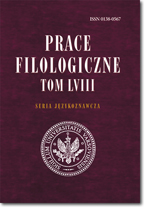Wyrażenia związane z niejawnością działań w opisie leksykograficznym
The Expressions Concerning the Non-Transparence of Activities in the Lexicographical Descriptions
Author(s): Celina HeliaszSubject(s): Language and Literature Studies
Published by: Wydział Polonistyki Uniwersytetu Warszawskiego
Keywords: leksykografia; semantyka; pragmatyka; jednostka leksykalna; synonim; znaczenie; forma; przymiotnik; przysłówek; lexicography; semantics; pragmatics; lexical unit; synonym; meaning; form; adjective; adverb
Summary/Abstract: The paper presents some general problems with the lexicographical description of lexical units using the example of adverbs and adjectives (that are in a derivational relation) concerned with non-transparence of activities. By non-transparence of activities I mean a mode of doing something whose aim is not to deliver information about one’s activities to some other persons. The adverbs which represent this meaning in Polish are, among others, {potajemnie, skrycie, ukradkiem, chyłkiem, cichaczem}. The subject matter are lexical units and their definitions found in monolingual Polish language dictionaries of different types: general language dictionaries, dictionaries of synonyms and antonyms and a dictionary of grammar. The material analysed from dictionaries is verified with the method of semantic analysis given by Andrzej Bogusławski, especially with the tests of contradiction and implication. The paper discusses five cases. The first one is the problem of incorporating into modern language dictionaries outdated lexical units which nowadays exist in one lexicalized form of their former inflectional paradigm and function in a special new way, see: {ukradek – ukradkiem} in SGJP. The second issue, which is close to the first, is the ignorance of authors of dictionaries in distinguishing between the outdated and hypothetical units, as well as between the formal possibility of producing some forms of expressions and the semantic ban on it (see the example of *{skryciej} and *{potajemniej} in SGJP). Another issue is the case of adequate isolation and identification of lexical units in dictionaries, especially the necessity of eliminating false homonymous units which in fact are different uses of the same unit (see the case of multiple meanings of {cichaczem} and {chyłkiem}). The fourth problem, which is closely connected with the third, is the need for distinguishing between semantically relevant features of lexical units and their pragmatic features such as the possibility of occurrence in texts in concatenation with other (semantically defined) types of expressions (see:{pokątnie} which – regardless of its descriptions in dictionaries – does not mean ‘illegal’). Finally, the paper deals with the problem of defining the relation of synonymy among the units of interest in thesauruses of synonyms see: {utajniony, zamaskowany, potajemny} which in SS PWN are not adequately described as synonymous with {ukryty}.
Journal: Prace Filologiczne
- Issue Year: 2010
- Issue No: 58
- Page Range: 123-134
- Page Count: 12
- Language: Polish

